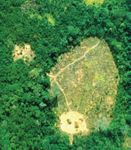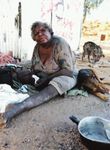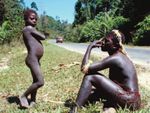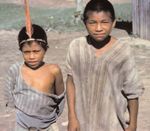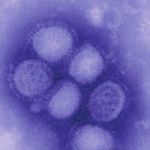Swine flu and tribal peoples
←
→
Page content transcription
If your browser does not render page correctly, please read the page content below
INTRODUCTION
TO DATE, HUNDREDS OF THOUSANDS OF
PEOPLE AROUND THE WORLD ARE KNOWN
TO HAVE CONTRACTED SWINE FLU; APPROXIMATELY
FOUR THOUSAND PEOPLE HAVE DIED FROM THE
VIRUS.2 THE WORLD HEALTH ORGANIZATION (WHO)
HAS DECLARED A GLOBAL FLU PANDEMIC.
TRIBAL PEOPLES ARE PARTICULARLY VULNERABLE
TO SWINE FLU. THOSE THAT ARE ISOLATED LACK
IMMUNITY TO FIGHT OUTSIDE DISEASES, WHILST
THOSE IN REGULAR CONTACT WITH OUTSIDERS
OFTEN SUFFER UNDERLYING HEALTH PROBLEMS
WHICH INCREASE THE RISK FROM THE VIRUS.
THE WHO HIGHLIGHTS INDIGENOUS POPULATIONS
AS AMONG CERTAIN SUBGROUPS AT RISK OF
HOSPITALIZATION AND DEATH FROM THE VIRUS,
‘ I am rather fearful that
ADDING THAT STUDIES HAVE SHOWN THAT THE RISK
IS ‘FOUR TO FIVE TIMES HIGHER THAN IN THE
there will be more deaths GENERAL POPULATION’.3
from this illness in indigenous
HEALTH EXPERTS ACROSS THE WORLD HAVE
populations. The underlying EXPRESSED THEIR CONCERNS ABOUT THE IMPACT
factor is that indigenous people OF SWINE FLU ON TRIBAL COMMUNITIES, CALLING
ON GOVERNMENTS TO MAKE SPECIAL PROVISIONS
are susceptible to infections
FOR THEIR COUNTRIES’ INDIGENOUS POPULATIONS.
because they have low immunity,
they’re often undernourished, THIS REPORT TAKES A CLOSE LOOK AT
HOW SWINE FLU HAS AFFECTED TRIBAL
and they often have pre-existing
COMMUNITIES SO FAR, AND THE POTENTIAL
illnesses. ’ IMPACT IT MAY HAVE ON THE HEALTH OF THE
Professor Michael Gracey, Curtin University, Australia 1 WORLD’S MOST VULNERABLE PEOPLES.
1ABOUT SWINE FLU
Swine influenza is a disease found in pigs. Although anyone is susceptible to the virus,
Although such flu is a regular occurrence, people who are most at risk of developing
and does not normally affect people, this complications from swine flu are those
particular viral strain (H1N1) has mutated, with chronic health problems, including
making it possible to infect humans and be respiratory, heart, kidney and liver disease.4
transmitted between one person and another.
Hundreds of thousands of people across the
Swine flu is highly contagious, spreading in world are known to have contracted swine
much the same way as regular flu. The virus flu; approximately four thousand people
can live on hard surfaces for up to 24 hours, have died as a result of the virus. Most of
and a soft surface for around 20 minutes, the deaths have been among people with
making it easily transferable from person underlying chronic health problems.
to person.
THE HEALTH GAP
and a shift from nomadic to settled life,
Tribal peoples are at greater risk from swine
flu because many are living in poverty, even
in affluent countries, with severe underlying
health problems. Chronic diseases such as
diabetes, heart disease and respiratory
disease are often higher in tribal communities,
putting them at greater risk of complications ‘ It is depressingly predictable,
from swine flu. According to the Lancet,
and you don’t have to evoke complex
‘indigenous people have much higher rates
of infection than do their non-indigenous biological explanations for it. It brings
counterparts and these infections are likely
to be more severe or more frequently fatal’.5 home the well-known and quite sad
This disparity stems from colonization and fact that indigenous communities are
assimilation policies, which have seen tribal
peoples removed from their lands and forced
at risk for all sorts of reasons. ’
to abandon their traditional ways of life. Dr Andrew Pesce,
Changes to diet, housing, livelihood, culture President of the Australian Medical Association.6
2have had a profound impact on the health Underlying all these illnesses is dislocation
and well being of tribal peoples.7 from ancestral lands, marginalization and
loss of an independent livelihood. Where
Many tribal peoples who have lost their lands tribal people live independently on their
and ways of life suffer poor living conditions, own lands, eating traditional foods, they
including overcrowding and poor sanitation, can continue to be healthy and strong,
poor nutrition and greater exposure to and their communities thrive.9
infections. As a result, many suffer diseases
of poverty including tuberculosis, and skin
and respiratory infections. For many tribal
communities there has not been a significant
increase in medical provision, and reliable
access to good healthcare remains unavailable
and/or unaffordable.
Simultaneously, many poor, displaced tribal
peoples also suffer from diseases of affluence,
such as diabetes and obesity, as a result of
rapidly changing lifestyles. A change in diet
to high-calorie, fatty foods, coupled with
decreased physical activity and alcohol and
drug misuse, has had a profound impact
on indigenous peoples’ health. ‘Diabetes,
cardiovascular disease, and tobacco use
account for half of the indigenous health gap’, Thrown off their lands, many Brazilian Guarani
are forced to live by the side of the road. This
not to mention the mental health problems
level of poverty puts them at greater risk of
and disproportionately high levels of suicide
complications from swine flu.
that accompany such a change in lifestyle.8
THE IMPACT OF SWINE FLU
It is difficult to accurately assess the impact
of swine flu on tribal peoples, given that
statistics are constantly changing as the
‘ I firmly believe that this
virus continues to spread, and also because pandemic will reveal – in a highly
of the lack of research into populations that
visible, measurable, and tragic
are at higher risk. However, looking at what
is happening in Australia and Canada, we way – exactly what it means, in
can see the disparity between indigenous
and non-indigenous health come into play, life-and-death terms, when health
as the virus sweeps through the countries’
indigenous communities.
needs and health systems have
been neglected, for decades,
First Nations in Manitoba, Canada,
have seen infection rates of 130 per
in large parts of the world. ’
100,000 compared to 24 per 100,00 WHO Director-General Margaret Chan.10
for the general population.
3CANADA
Native Canadians are in much poorer health that the community had received no
generally than their non-native neighbours. resources and simply wasn’t prepared
They have high rates of chronic diseases to deal with the outbreak.16
including obesity, diabetes, heart disease
and alcoholism, and have a life expectancy Overcrowding has been blamed for the spread
of 7.4 years (men) and 5.2 years (women) of the virus among native communities. Glen
less than the respective all-Canada statistics.11 Sanderson, a policy analyst for Manitoba’s
northern First Nation communities, has
The Canadian government has described described reserves as a ‘breeding ground for
a ‘rising epidemic’ of type 2 diabetes among the virus to spread’, adding that ‘when you’ve
the First Nations communities, with Native got as many as 11 people walking around the
people 420% more likely to die from diabetes house, it really will spread to everybody’.17
than their non-Native counterparts.12 Obesity
is also a major problem, with up to 30% of That Canada’s native population has been
Inuit women now diagnosed as clinically disproportionately affected by the recent
obese.13 strain of swine flu is nothing new. The same
disparity has been seen in previous flu
outbreaks, including the 1918 Spanish flu
Swine flu
which saw various indigenous communities
Canada’s indigenous population has been
devastated by the virus. The village of Cris,
hard hit by swine flu with aboriginal leaders
Manitoba, for example, saw 20% of the
declaring a state of emergency in response
population die over a six-week period.18
to the high rates of infection among First
Nations people. The country’s prime minister,
Ethan Rubinstein, professor of infectious
Stephen Harper, has expressed concern about
diseases at University of Manitoba, has
the levels of swine flu among First Nations
suggested that the current swine flu pandemic
communities, saying, ‘We are very concerned,
will follow much the same pattern as the 1918
obviously, about H1N1 generally and, in
Spanish flu, though he does not expect the
particular, the high incidence we’ve seen in
same death toll.19
aboriginal communities, particularly in
Manitoba.’14
First Nations communities in the province Government’s response
of Manitoba have been badly affected by In response to the outbreak, the Assembly of
the pandemic. It has been reported that Manitoba Chiefs turned to corporate donations
while the swine flu infection rate in the in a bid to raise $1.5 million to buy medical kits
general population has seen an infection for First Nations communities in the province.
rate of 24 per 100,000, First Nations in Grand Chief Ron Evans told the Canadian
Manitoba have seen rates of 130 per Press that First Nations people could not wait
100,000, and they constitute the majority ‘to see what the federal government is going
of those in intensive care in the province.15 to do’.20
Health clinics in the Split Lake Cree First The Manitoba government has appointed
Nation, about 120 km north of Winnipeg, a special health adviser to work with
have been overwhelmed and the school First Nations communities on swine flu.
had to be closed as so many children However, the federal government has been
contracted swine flu. Mike Moose, health heavily criticized for its handling of the
director for the community, told CBC News outbreak among the indigenous population,
4AUSTRALIA
particularly its failure to deliver much-needed Like Native Canadians, Aborigines across
medical supplies to vulnerable communities. Australia are typically in much poorer health
than their non-indigenous counterparts. On
Health Canada, the country’s department of average, their life expectancy is 15-20 years
health, came under fierce criticism from the lower and they are 22 times more likely to die
Assembly of Manitoba Chiefs after it delayed from diabetes, 8 times more likely to die of
delivery of hand sanitizers (waterless coronary heart disease, 8 times more likely to
antibacterial hand-washing products) to die from lung disease and 6 times more likely
remote First Nations communities. Although to die from a stroke than the national average.23
many households in Manitoba’s reserves do
not have access to clean water with which to One major factor that explains these
wash their hands, the department spent two differences is poverty: average incomes
weeks debating whether to send the sanitizers. of the aboriginal population are only 62%
Their fear was that people living in reserve of those of the non-indigenous population.24
communities, where there are high rates of Aborigines have poor housing, poor access
alcoholism, would attempt to ingest the to resources – including health resources
alcohol in the sanitizers. – and a lethal combination of loss of traditional
knowledge coupled with a lack of education.
The Assembly of Manitoba Chiefs said Such poverty has given rise to a multitude of
some communities had to wait almost a chronic illnesses, leaving Aborigines especially
month before they received the sanitizers vulnerable to the swine flu pandemic.
they needed to fend off swine flu. Dr Kim
Barker, a physician who works for the
Assembly, is reported to have said, ‘We heard
that ... people were spending days discussing
the pros and cons of a non-alcohol-based
hand sanitizer versus an alcohol-based one
because of the concerns about addictions in
communities. It was absolutely outrageous.’21
In the Garden Hill First Nations community,
the government’s delay led Chief David
Harper to take $15,000 from the community’s
education fund to buy supplies in response to
an outbreak of swine flu on the reserve. After
waiting weeks for the supplies, Harper used
money intended to buy laptops for students,
to stock up on masks and hand sanitizers.
A week after the $15,000 was spent, 2,500
bottles of government-issued hand sanitizer
were delivered.22
The life expectancy of Australian Aborigines
is 15-20 years less than other Australians.
5Swine flu
At the time of writing, tens of thousands promised free flu shots for Aborigines, along
of people in Australia are known to have with other ‘high risk’ groups including pregnant
contracted swine flu. However, it seems that women and the chronically ill.
the country’s indigenous population has been
the worst affected group, as Aboriginal people In response to the outbreak on Palm
account for almost one in ten of the fatalities, Island, a special clinic has been set up and
despite only accounting for 2% of the total supplies of anti-viral drugs have been flown
population. in. However, community elders have criticized
the government for its handling of the
Indeed, the country’s first fatality from the epidemic, arguing that government advice
virus was a 26 year-old Aboriginal man from has not reached their communities.
Kirrikurra community in Western Australia. The
man was known to suffer from a number of Speaking to the New York Times about the
serious illnesses prior to contracting swine flu. Australian government’s failure to take into
consideration the needs of the country’s
Swine flu has hit residents of the country’s Aborigine population, Alf Lacey, the mayor
largest Aboriginal community on Palm Island, of Palm Island, said, ‘There are a lot of barriers
north Queensland. The most recent victim of in terms of culture and particularly cultural
swine flu was a young pregnant woman who awareness for people who are working in
lost her unborn baby after contracting the virus Aboriginal communities. Putting up a generic
and was left in a critical condition. poster isn’t going to do much good if you’re
dealing with people who can’t read.’27
Poor living conditions have been blamed
for the spread of the virus, as residents
struggle with overcrowding, giving rise to WHAT DOES THIS MEAN?
chronic health problems and poor nutrition. Canada and Australia’s experience shows
Associate Professor Gracelyn Smallwood, that tribal peoples are more vulnerable to
who has worked on indigenous health for swine flu than their non-tribal counterparts
over 40 years, told the Australian, ‘If you have and sends a clear signal to other countries
a population of 3,000 people with only 300 to make special provisions for their
houses, then people are vulnerable… it’s indigenous populations.
not Einstein stuff.’25
Professor Michael Gracey, Professor of
Swine flu has also spread across Aboriginal Aboriginal Health at Curtin University, has
communities in the Northern Territory; at the expressed concern about what Australia
time of writing, half of the 78 swine flu cases and Canada’s experience could mean for
are indigenous people and of the three indigenous peoples in developing countries.
fatalities in the area, two were Aboriginal ‘These countries [developing countries]
people. It is perhaps no coincidence that have very large indigenous populations and
among Aboriginal communities in the Northern they do not have the underlying public
Territory, only 13% of settled households health infrastructure and preventive
surveyed had functioning water, waste, programs and the capability for dealing
cooking and cleaning facilities.26 with pandemics that Canada, Australia,
and the U.S. do.’ 28
Government’s Response
Following concerns about their vulnerability
to swine flu, the Australian government has
6ISOLATED AND RECENTLY-CONTACTED PEOPLES
Perhaps the greatest cause for concern are
the world’s isolated peoples, those with little
‘ Isolated tribes have no immunity
or no regular contact with non-indigenous to the infectious diseases that
populations, and those who have recently
been contacted by outsiders. Such peoples circulate through our industrial
lack immunity to outside diseases – even the
common cold can prove fatal to tribes who society and will be particularly
have never been exposed to the virus before
susceptible to swine flu. This
– making them extremely vulnerable to a
swine flu pandemic. could be devastating, infecting
Swine flu has already reached the Peruvian whole communities simultaneously,
Amazon, with seven members of the
Matsigenka tribe testing positive for the
leaving no-one to care for the
virus. Although all seven have now recovered,
it raises fears of a contagion among
sick or bring in and prepare food. ’
neighbouring uncontacted tribes who Dr Stafford Lightman, Professor of Medicine,
lack immunity to outside diseases. University of Bristol.29
In Brazil, the Conference on Indigenous
Education, scheduled for 21st September,
was cancelled because of the risk of swine
flu.30 There are also reports of Indians in Brazil
fleeing riverbanks into the forests to escape
contact with outsiders carrying the virus.31
Such fear is justified. History has shown
that entire communities can be wiped out
by the introduction of diseases. For example,
between 1967 and 1975 one Yanomami
community in Roraima, Brazil, was totally
wiped out by measles. Other villages in the
area suffered a dramatic population decline
of up to 70% because of diseases spread Seven members of the Matsigenka tribe
by road builders.32 have already tested positive for swine flu.
7Travel and tourism
Isolated tribes have long been an attraction However, the WHO has dismissed attempts
for tourists keen to catch a glimpse of such to screen passengers on entry and exit as
peoples. Tourist developments have been built futile, arguing that they do not work to reduce
in areas close to isolated tribes, and there are the spread of swine flu. It also argues that
even ‘first contact’ expeditions on offer, imposing travel restrictions on passengers
apparently promising tourists the chance to would have little effect on stopping the spread
contact uncontacted tribes. Even at the best of the virus, advising countries to focus instead
of times, such tourism can spell disaster for on minimizing the impact of severe outbreaks.35
isolated tribes who find themselves unwittingly
exposed to diseases previously unknown to One tribe in the US postponed a major
them. But at a time of a global pandemic, such village event for fear of international visitors
ventures are cause for even greater concern. introducing swine flu to the community. The
Havasupai tribe, whose village in the Grand
International travel is central to the spread Canyon flooded last August, postponed the
of swine flu and other infectious diseases. re-opening of the community. Matthew
A study conducted by infectious disease Putesoy, village vice-chairman, said, ‘We’re
physician Dr Kamran Khan accurately a small isolated community. People come
predicted the spread of the swine flu virus from all over the world to visit and even though
by tracing the destinations of passengers we’ve lost our economy, we couldn’t take
leaving Mexico. Their findings showed a the risk’.36
clear connection between the international
destination of air passengers and the spread However, most isolated tribes are not in a
of the virus across the world.33 position to control who enters their lands. As
passengers continue to travel internationally,
Research has shown that aircraft passengers swine flu continues to spread and the risk of
develop colds with a higher than normal the virus to isolated peoples increases.
frequency the week following their flights,
and findings show an average of 20% of
passengers develop such infections after
flights.34 Tourists just stepping off international
flights therefore play a key role in the spread
of swine flu, carrying the virus from country
to country. And those who move straight
from the airport to areas of close proximity
to isolated tribes risk introducing the virus
to some of the most vulnerable peoples in
the world.
There have been various attempts to curb
the spread of swine flu by international flights.
Some airline companies, including British
Airways and Virgin Atlantic, have started
preventing people displaying symptoms of
the virus from boarding flights and there have
also been attempts to screen passengers for
As passengers continue to travel internationally
the virus at airports, using thermoscanners to
and swine flu continues to spread, the risk of the
check for fevers, one of the key symptoms of virus to isolated peoples increases.
swine flu.
8JARAWA
The Jarawa are nomadic and self-sufficient,
and have only had contact with outsiders
since 1998. The majority of the tribe live
deep in the forest, isolated from the islands’
mainstream population, which makes them
vulnerable to epidemics. In 1999, many
Jarawa suffered from respiratory tract
complications after a measles outbreak;
50% of the population are thought to
have contracted measles at this time.37
However some, mostly younger members Jarawa by the side of the Andaman Trunk
of the Jarawa do have contact with non-tribal Road, which runs through the tribe’s land.
people through the Andaman Trunk Road that
cuts though the heart of the tribe’s reserve.
The Road brings the Jarawa into contact with bringing with them a multitude of diseases and
tourists and settlers who risk passing swine infections previously unknown to the people.
flu on to the tribe.
In Peru, Perenco, an Anglo-French company,
The Jarawa also risk contracting swine has a huge oil project in the country’s northern
flu from tourists as a result of resorts close Amazon, in an area inhabited by at least two
to their reserve. For example, Barefoot, uncontacted tribes. One of the tribes is
a travel company with resorts in the believed to be a sub-group of the Waorani,
Andamans, recently opened a new and the other is known as the Pananujuri.
resort situated dangerously close to the
Jarawa reserve. Although there are other Perenco claims the area is uninhabited, but
developments bringing the Jarawa in closer the Peruvian government, the Ecuadorian
contact with outsiders, including the Trunk government, local indigenous organizations
Road, the international nature of Barefoot’s and countless experts have all recognized
clientele significantly increases the risk of the presence of isolated Indians in the area.
exposing the tribe to swine flu and other Despite the overwhelming evidence, Perenco
potentially fatal infections. Visitors to the plans to transport between 1,400 and 1,680
resort are likely to have very recently workers into the area, risking the introduction
travelled on international flights. of disease and infection, including swine flu.
Survival is calling for the Andamans’ Similarly, in Paraguay, the isolated Ayoreo-
administration to take emergency action Totobiegosode face threats from land
to minimize contact between the Jarawa speculators and ranchers invading their
and outsiders at this time. This includes lands in the Chaco, a vast expanse of dense,
closing the Andaman Trunk Road, and for scrubby forest stretching from Paraguay to
all tourist resorts and attractions within Bolivia and Argentina. Their territory is now
the proposed 5km buffer zone from the being rapidly cleared by private landowners
reserve to be closed. and wealthy cattle-ranching businesses.
Some of the Ayoreo came out of the forests
in 1998 and 2004, as a result of continual
LOSS OF LAND
invasion of their lands. However, many remain
Isolated tribes face threats from oil uncontacted and particularly vulnerable to the
workers, illegal loggers, ranchers and introduction of diseases from workers invading
settlers encroaching on their land and their lands.
9Survival has long been calling for the land
rights of isolated peoples to be recognized
and protected. However, in times of a global
pandemic, this takes on an added urgency.
Any encroachment on their land could
introduce swine flu to isolated tribes,
with disastrous consequences.
CONCLUSION
‘ As leaders of a vulnerable
population living in Third World
conditions, First Nations deserve
no less attention. ’
Assembly of Manitoba Chiefs.38
The current swine flu pandemic has • Alerting health professionals to
affected hundreds of thousands of people the elevated risk of the virus to tribal
across the globe. However, it has hit communities;
indigenous populations in Australia and
• Educating tribal communities’ health
Canada particularly hard, serving to highlight
workers about the disease, its symptoms
the disparity between indigenous and non-
and ways of minimizing transmission;
indigenous health, which although well known,
has remained largely unaddressed. • Quickly providing tribes with necessary
supplies of medications and other equipment;
The threat of swine flu to isolated and recently
contacted tribes is real and cause for great • Taking all possible steps to protect isolated
concern, particularly given that the virus has tribal communities from forced contact with
already reached areas very close to where such outsiders, including closing roads, resorts
peoples live. The introduction of the virus to and other operations that threaten the tribes’
isolated tribes, as with any other new disease, isolation;
could have devastating consequences.
• Immediately removing all illegal loggers,
Survival is urging governments and healthcare oil workers, ranchers and poachers operating
agencies across the world to make special on lands belonging to isolated or uncontacted
provisions for tribal peoples during the swine peoples.
flu pandemic, particularly:
Governments need to acknowledge
• Ensuring that information about swine flu is the vulnerability of tribal peoples to the
made available to tribal peoples in appropriate virus and take special measures to ensure
formats and languages; that indigenous communities are well
equipped to deal with an outbreak.
10Footnotes
1
Vancouver Sun, July 3 2009
2
http://www.who.int/csr/don/2009_08_28/en/index.html
3
http://www.who.int/csr/disease/swineflu/notes/h1n1_second_wave_20090828/en/index.html
4
http://www.nhs.uk/Conditions/Pandemic-flu/Pages/QA.aspx
5
Gracey, M and M. King. 2009. Indigenous health part 1: determinants and disease patterns. The Lancet, vol. 374:68
6
http//www.nytimes.com/2009/08/16/world/asia/16australia.html
7
Survival International, 2008. Progress can kill p.10
8
Gracey, M and M King. 2009. Indigenous health part 1: determinants and disease patterns. The Lancet, vol. 374:72
9
Survival International, 2008. Progress can kill p.1
10
UN/Global Health Forum, 15 June 2009, New York
11
Survival International, 2008. Progress can kill, p.11
12
Survival International, 2008. Progress can kill, p.11
13
Survival International, 2008. Progress can kill, p.19
14
http://www2.canada.com/topics/news/story.html?id=1732690
15
http://www2.macleans.ca/2009/07/16/people-at-risk/#more-69592
16
http://www.cbc.ca/canada/manitoba/story/2009/06/08/mb-influenza-winnipeg.html
17
http://www.cbc.ca/canada/manitoba/story/2009/06/08/mb-influenza-winnipeg.html
18
http://www.abs-cbnnews.com/world/07/29/09/canada-natives-fear-swine-flu-spread-coming-months
19
http://www.abs-cbnnews.com/world/07/29/09/canada-natives-fear-swine-flu-spread-coming-months
20
http://www.macleans.ca/canada/wire/article.jsp?content=n19704614
21
http://www.ctv.ca/servlet/ArticleNews/story/CTVNews/20090623/first_nations_/20090623
22
http://www2.macleans.ca/2009/06/26/the-unseen-costs-of-swine-flu
23
Survival International, 2008. Progress can kill, p.12
24
Survival International, 2008. Progress can kill, p.12
25
The Australian, July 22 2009
26
Survival International, 2008. Progress can kill, p.13
27
http://www.nytimes.com/2009/08/16/world/asia/16australia.html
28
http://www.vancouversun.com/health/swine-
flu/Swine+potential+devastate+indigenous+populations+worldwide+medical+journal+reports/1754987/story.html
29
Correspondence with Survival International
30
http://www.agenciabrasil.gov.br/
31
Terra Noticias, August 19 2009
32
Survival International, 2008. Progress can kill, p.4
33
The Canadian Press, June 29 2009
34
Hocking and Foster, 2004. Common cold transmission in commercial aircraft: industry and passenger implications.
Journal of Environmental Health Research, Vol.3, Issue 1
35
WHO, May 7 2009, Global Alert and Response
36
http://motherearthjournal.blogspot.com/2009/05/h1n1-flu-spreads-to-over-20-states.html
37
The High Court commissioned Expert Committee on Health and Hygiene 2003 described the respiratory tract infection as
‘a major killer disease among the Jarawas’.
38
http://www.manitobachiefs.com/index1.html
© Survival 2009.
Photos: p2 & 3: Guarani mother and child, Brazil © João Ripper/Survival;
p5: Aborigine woman, Alice Springs, Australia © Ceanne Jansen/Survival;
p7 (top): Uncontacted tribe, Brazil © Gleison Miranda/FUNAI; (bottom):
Matsigenka children, Peru © Survival; p8: Remote Uru Eu Wau Wau village,
Brazil © Fiona Watson/Survival; p9: Jarawa, Andaman Islands © Salomé/
Survival; p10: Yanomami girl, Brazil © Victor Englebert/Survival.
6, Charterhouse Buildings,
Survival International
London EC1M 7ET, UK
T + 44 (0)20 7687 8700
info@survivalinternational.org
www.survivalinternational.orgYou can also read

